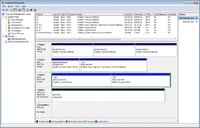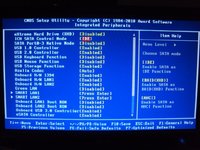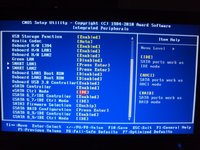priyadarshi
Right off the assembly line
Hello everyone!
I need help configuring my SSD into right SATA port to install 64Bit Windows 7 Ultimate on it. This is my current system config.
Core i7 930 2.80Ghz
X58A-UD7 (rev.1.0) GIGABYTE - Motherboard - Socket 1366 - GA-X58A-UD7 (rev. 1.0)
Kingston SSDnow V100 64GB (SV100S2/64G)
HDD WD Caviar Green 2TB (WD20EARX)
HDD WD Caviar Black 1TB (WD1001FALS)
HDD WD Caviar Green 500GB (WD5000AADS)
G.Skill 3X2GB DDR3 1333Mhz (F3-10666CL9T-6GBNQ)
Kingston 1X4GB DDR3 1333Mhz (KVR13N9S8-SP)
On my motherboard there are 10 SATA ports. According to the manual they are:
SATA2_0 (Blue in Colour) = IDE Channel 0 Master (Connected SSD as my SSD is a SATA2 3Gb/s device and updated with Firmware Rev. 120229)
SATA2_1 (Blue in Colour) = IDE Channel 1 Master (Connected SATA DVD Writer)
SATA2_2 (Blue in Colour) = IDE Channel 0 Slave (Connected Gigabyte SATA Bracket)
SATA2_3 (Blue in Colour) = IDE Channel 1 Slave (Connected Gigabyte SATA Bracket)
SATA2_4 (Blue in Colour) = IDE Channel 2 Master (Connected 1TB HDD)
SATA2_5 (Blue in Colour) = IDE Channel 3 Master (Connected 500GB HDD)
SATA3_6 (White in Colour) = IDE Channel 6 Master (Connected 2TB HDD as this HDD is a SATA3 6Gb/s Device)
SATA3_7 (White in Colour)
SATA2_8 (White in Colour) (Connected Chasis I/O panel eSATA Bracket)
SATA2_9 (White in Colour)
After getting my SSD I did the following steps to install the OS.
1. Deleted all partition from 500GB HDD as it contained only the OS
2. Unplug all HDD
3. Connected SSD
4. Installed 64Bit Windows 7 Ultimate
5. Connected all HDD and made partition as shown in Disk Management in my attachment.
After installing the OS on SSD which is on IDE Channel 0 Master in BIOS it shows in Disk 0 when none of the HDD was connected. But after connecting the hard drives the same SSD shows as Disk 1 in Disk Management.
Now, I want these three changes when I clean install Windows 7 again.
1. Install OS in AHCI mode for better performance.
2. Configure SSD on Disk 0
3. Activate the Windows feature for "Safely Remove Hardware" for my eSATA device.
For these changes:
a. Do I need to change ICH SATA Control Mode under Integrated Peripherals to "AHCI" in BIOS
b. Change SATA port? But I don't want to change 2TB HDD's port as its a 6Gb/s device and I want to save SATA3_7 (White in Colour) port for future use.
c. Do I need to change eSATA Ctrl Mode under Integrated Peripherals to "AHCI" in BIOS
I need help configuring my SSD into right SATA port to install 64Bit Windows 7 Ultimate on it. This is my current system config.
Core i7 930 2.80Ghz
X58A-UD7 (rev.1.0) GIGABYTE - Motherboard - Socket 1366 - GA-X58A-UD7 (rev. 1.0)
Kingston SSDnow V100 64GB (SV100S2/64G)
HDD WD Caviar Green 2TB (WD20EARX)
HDD WD Caviar Black 1TB (WD1001FALS)
HDD WD Caviar Green 500GB (WD5000AADS)
G.Skill 3X2GB DDR3 1333Mhz (F3-10666CL9T-6GBNQ)
Kingston 1X4GB DDR3 1333Mhz (KVR13N9S8-SP)
On my motherboard there are 10 SATA ports. According to the manual they are:
SATA2_0 (Blue in Colour) = IDE Channel 0 Master (Connected SSD as my SSD is a SATA2 3Gb/s device and updated with Firmware Rev. 120229)
SATA2_1 (Blue in Colour) = IDE Channel 1 Master (Connected SATA DVD Writer)
SATA2_2 (Blue in Colour) = IDE Channel 0 Slave (Connected Gigabyte SATA Bracket)
SATA2_3 (Blue in Colour) = IDE Channel 1 Slave (Connected Gigabyte SATA Bracket)
SATA2_4 (Blue in Colour) = IDE Channel 2 Master (Connected 1TB HDD)
SATA2_5 (Blue in Colour) = IDE Channel 3 Master (Connected 500GB HDD)
SATA3_6 (White in Colour) = IDE Channel 6 Master (Connected 2TB HDD as this HDD is a SATA3 6Gb/s Device)
SATA3_7 (White in Colour)
SATA2_8 (White in Colour) (Connected Chasis I/O panel eSATA Bracket)
SATA2_9 (White in Colour)
After getting my SSD I did the following steps to install the OS.
1. Deleted all partition from 500GB HDD as it contained only the OS
2. Unplug all HDD
3. Connected SSD
4. Installed 64Bit Windows 7 Ultimate
5. Connected all HDD and made partition as shown in Disk Management in my attachment.
After installing the OS on SSD which is on IDE Channel 0 Master in BIOS it shows in Disk 0 when none of the HDD was connected. But after connecting the hard drives the same SSD shows as Disk 1 in Disk Management.
Now, I want these three changes when I clean install Windows 7 again.
1. Install OS in AHCI mode for better performance.
2. Configure SSD on Disk 0
3. Activate the Windows feature for "Safely Remove Hardware" for my eSATA device.
For these changes:
a. Do I need to change ICH SATA Control Mode under Integrated Peripherals to "AHCI" in BIOS
b. Change SATA port? But I don't want to change 2TB HDD's port as its a 6Gb/s device and I want to save SATA3_7 (White in Colour) port for future use.
c. Do I need to change eSATA Ctrl Mode under Integrated Peripherals to "AHCI" in BIOS




